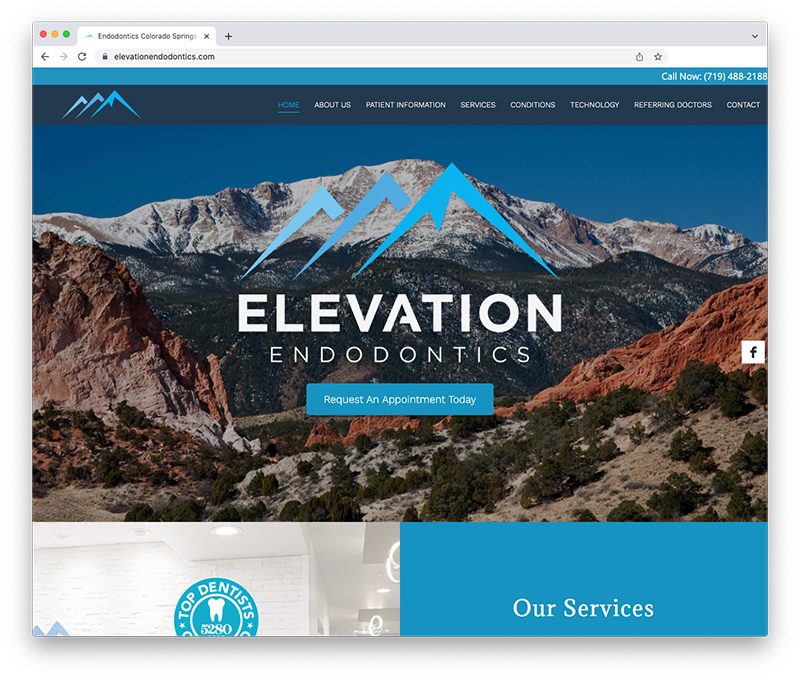
Mastering Endodontist Marketing: Top 17 Proven Strategies
Let’s get to the root of your Endodontic marketing strategy.
As an Endodontist, the way you market and attract new patients is different from a general family dentist or orthodontist—but that doesn’t mean you can’t use proven organic marketing strategies to improve and grow your practice.
These nine tips can help you bring more patients through the door, improve your reputation, and build a better brand around your practice. Some of these strategies you may be able to tackle in-house, while others you may want to recruit some help from the experts. It all depends on the time and resources you have to dedicate toward marketing your Endodontist practice.
1. Update to a Modern Dental Website Design
An updated, functional, and modern website design is the cornerstone of any marketing strategy. It is often the first impression that potential patients and referring dentists have of you and your practice. It can really set the tone before they even have a chance to talk to you.
A knock-out dental website design comprises several elements that make the website experience super slick for your visitors. Up front, your website design should be clean and easy to navigate. You can use stock images but don’t shy away from taking some in-house photos to personalize your website. Your homepage should quickly deliver the most important information first (contact information, positive reviews, essential links, and how to contact and find your practice). This improves user experience and conversion rates which will boost your website rankings.
As you tackle your new website design, run through this checklist of essential features and rank-boosting tasks that will result in a powerful and beautiful website:
2. Optimize your Website for Technical SEO
A pretty website doesn’t guarantee good performance. When you update your website design, don’t forget about the technical elements that run your site behind the scenes. This includes technical SEO. SEO (Search engine optimization) refers to improving your practice’s position on a search results page. If you’re unsure where your practice lands, grade your website to see if it’s technically proficient.
If your website is in need of a little polishing up in the technical department, you’ll want to look at the following:
- Webpage Speed: No matter who is visiting your site, you only have about three seconds of load time before most of them will move on to something else. The expectation that your site loads and functions smoothly is high.
- Mobile Optimization: More searches are done on mobile devices than desktops, which means your website needs to be optimized to function well on all devices.
- Website Security and HIPAA Compliance: Protecting patients’ information is a no-brainer. Proper website security is a requirement for HIPAA. Your website security and HIPAA compliance on your website need to protect any information that is collected or transmitted.
While there are many aspects to a strong SEO strategy (and it feels like it’s always changing), SEO can be one of the biggest factors in getting your practice more p[atient referrals and bringing more traffic to your website. By utilizing keywords in the proper places, internally and externally linking your website, and improving your overall website experience, you can put the rules of SEO to work for you. To learn more about dental SEO, read SEO dental industry articles and follow these SEO online publications.
All of this will help your practice rank higher in search–which is one the quickest ways to get found by patients and general practice dentists looking for endodontists in your area.
3. Rank Higher on Google Maps
To make an impression on your local dental scene, you have to have a Google Business Profile (GBP). Your GBP will ensure that your practice shows up on Google Maps for your local area. The ultimate goal is to land in the Google Map 3-Pack. The Google Map 3-Pack is the first three results shown on the Search Engine Results Page (SERP) on Google Search.
When you optimize your GBP, you’ll rank higher on search results and drive new eyes to your website and practice. You will want to have current contact information, updated photos, positive patient reviews, and more when rounding out your profile.
A GBP is free and relatively easy to set up. For help in optimizing your GBP check out this Endodontic marketing video.
4. Attend the Dental Digital Marketing Conference
Sometimes you need to inject a fresh dose of creativity by networking with other dentists and learning the latest marketing strategies. The best place to do this is a dental marketing conference!
While most dental conferences will have some resources dedicated to marketing, there is an advantage to attending a conference specifically geared toward dental marketing. You can devote your time to learning how to expand and grow your practice.
Endodontists have unique marketing needs, and connecting with other dental professionals in the same industry can be extremely beneficial to your practice. Other benefits of attending a dental marketing conference include:
- Get hands-on experience and helpful practical tips.
- Get inspired by success stories and strategies from other practices across the country.
- Learn the latest trends for endodontists and how you can bring more business to your practice.
- Network with other professionals and learn from their experience.
- Connect with valuable resources and dental marketing experts to help you achieve your marketing goals.
Want to attend an upcoming dental marketing conference? We host the Dental Digital Marketing Conference each year.
5. Start a Endodontic Blog
For some, blogging might be on par with getting a root canal, but hang in there, this won’t hurt a bit.
Blogging is the meat and potatoes of your dental SEO strategy. It’s one of the most powerful ways to give your website the push it needs to climb to the top of the Search Engine Results Page (SERP).
A consistently updated blog gives you numerous opportunities to improve your website performance, increase your credibility, and create content that can be repurposed across your other marketing channels. It can become a valuable resource for your incoming patients and show potential partners that you are proactive, up-to-date, and knowledgeable about the latest in Endodontics.
So how do you start a professional blog? Here’s what dental marketing experts have to say about it:
- Remember: You aren’t your intended audience. Write content that answers questions and solves problems for potential patients, not for other Endodontists. Start with FAQs and move into other topics related to Endodontics, root canals, and dentistry.
- Infuse your practice personality into your blogs. Your blogs don’t have to read like an article from the latest dental research magazine. This is a great space to incorporate a little more lighthearted content while approaching some serious topics.
- Make an outline for each blog. Both the Google algorithm and real-life readers prefer content that is easy to read or even skim. This comes in the form of utilizing headers and subheadings in your blog. Bullet points (like this one), make delivering important information quick and easy.
- Give your readers something to take away. You don’t have to reinvent the wheel, but give your readers a reason to read. This includes a catchy blog title to reel them in from the start. Add a clear call to action within your blog that pushes readers toward the next step.
- Done is better than perfect. No one is handing out grades for your blog work, so instead of fretting over minor details, hit publish. Make and keep to a consistent blog schedule so that you can start building your library of content.
Consider outsourcing your writing needs. If you have the option, outsourcing your blog writing can save you precious time and give you the consistency you need. You can hire a freelancer or work with a dental marketing company. Choose a writer that has experience in your industry or who can match the tone and style of your practice. Ask for a sample of their work before you get started.
6. Get More Google Reviews than Your Competition (Especially GP’s)
Google reviews are as valuable as gold. A Google review is like word-of-mouth marketing and they live permanently on your Google Business Profile. When it comes to Google reviews: the more, the merrier.
Having a large number of positive reviews can help you to rank better but more importantly they encourage patients to choose you over the competition. You might be surprised at how many people will check reviews before they see you.
Multiple online consumer studies have shown that around two-thirds of potential patients will read your reviews before they call to schedule. Not only are future patients reading your reviews, but referring dentists as well. They need to know that they can confidently pass on referrals and continue a positive patient experience.
All of your other marketing initiatives could be undermined by bad, outdated, or absent reviews, so start by getting more Google reviews. Make it a regular part of your patient experience so that you’re always building your Google Business Profile.
7. Do Good with Charity Endodontic Marketing
A good cause is a great way to rally your team, help your community, and do a little Endodontist marketing on the side. You can even bring patients and staff together to achieve your goal. This can be as simple as a humanitarian drive, or as life-changing as sponsoring a patient in need.
Choose a cause that is important to you and your team, and it’s even better if it can benefit your local community. Community events can attract some positive press and build your reputation. They are a great opportunity to connect with local businesses or partner with other dental professionals. This can be a good place to attract new referrals.
When it comes down to it, it’s not about what a charity event can do for your practice. It’s about the good you can do and the unity you can build in and outside of your practice.
8. Bump Up Your SEO Rankings with a Blog Post Exchange
Now that you know how important a blog is, you can share your skills with referring dentists. Reach out to current and potential referring dentists and ask if they would like to do a blog exchange: you write a post for their blog, and they write one for yours. Getting your content on other websites is one of the best ways to boost your Endodontic SEO rankings.
When you do a blog exchange you create a credible inbound link to your website. These are also called external links and they are essential in the Google search algorithm.
Use a blog post exchange as a tool to support your current referring dentists and to introduce yourself to new referring dentists. When you make contact with a new referring dentist, mention you’d love to do a blog post exchange or offer a blog post to introduce their patients to your Endodontics practice.
The end goal is to drive organic traffic (traffic without ads) to your website so that your website attracts new visitors all on its own, while you’re busy seeing patients. Our free 7 Things Dental Websites Need! eBook provides more insight into everything your Endodontic blog needs to be a powerful asset for your practice.
9. Update Your Website to New HIPAA Compliance Requirements
As you cruise through website updates, don’t forget to have your website checked for HIPAA compliance. Protecting your patients’ information, and protecting your practice from costly violations is necessary in this digital age.
Your website needs to be properly encrypted and secure so that any Patient Health Information (PHI) is completely safe. Under the law, patients are required to have access to their electronic health records (EHRs), so make sure you understand how to properly secure their information.
Everything you do online should follow the proper HIPAA compliance. It can feel overwhelming, but you can read dental HIPAA questions you’re afraid to ask to brush up on the latest on online HIPAA compliance guidelines. Things like photos, reviews, and patient comments can be a little trickier to navigate. For example, do you know how not to respond to a negative online review? Even commenting on a patient’s experience from your point of view could put you and your practice at risk.
Check out this dentist’s guide to HIPAA compliance so that you know your website is doing everything it should to protect the privacy of your patients.
10. Get Comfortable Using AI
Artificial intelligence tools have infiltrated just about every industry now, including dentistry. ChatGPT, the large language model (LLM) owned by OpenAI, can be used for dental marketing efforts like creating social media captions or blog post drafts. You can also use it to brainstorm ideas by asking unusual dental patient questions like “Can dogs get root canals?”
Visual AI tools like Midjourney are also useful for creating marketing imagery for your endodontist website, blog, fliers, or social media posts. Even little details like your phone’s wallpaper can be personalized with dental themes through AI. These free cat and dog dental wallpapers for example were created using AI, and they’re adorable.
Get creative and experiment with AI. Copyright laws with AI are still largely undefined, so as long as you’re not using other people’s images without their consent, you should feel free to try out these tools for your endodontist practice.
11. Add Social Profile Links to your Google Business Profile
Your Google Business Profile (GBP) has the potential to grow your endodontist practice by leaps and bounds if you’re using it correctly. Along with Google Reviews (which boost your SEO), your Business Profile contains helpful information, keywords, and links to your website.
As of 2023, you now have the opportunity to add social profile links to your Google Business Profile as well. This is a great update because potential patients love having options when it comes to researching dental professionals.
By linking your practice’s social media profiles, prospective patients and referring dentists will be able to access these links as soon as they search your name on Google (rather than having to dig around your website first).
Creating a reliable GBP will also boost your search rankings on Google Maps. Find out how your practice ranks on Google Maps and if you need to work to improve your results.
12. Convert More Website Visitors with Live Chat
Your patients want options when it comes to communication. Some people prefer to call offices on the phone, but a growing number of people favor live chat as an easy tool for communicating online. Unlike chatbots which can only provide a few pre-selected answers to pre-selected questions, live chat provides a human connection that helps patients feel seen and heard.
Giving patients access to a 24/7 chat option can help your practice field unnecessary phone calls, reduce labor costs, and connect with more people looking for endodontic services. You can even install a chatbot or AI chat tool that transfers people to a live chat option when their questions aren’t answered.
If your endodontist practice is looking for a dental web chat tool that offers live chat functionality, My Social Practice offers this specialized service. Schedule a free consultation to find out how our reputation management tools can help your endodontics practice grow.
13. Respond to Every Patient’s Google Review
Gathering positive patient reviews on Google isn’t enough to make your online presence shine. To show patients that you really care, it’s important to respond to patient reviews as well. When people see an endodontist actively engaging with patients online, they see a practice that is aware of their patients, listens to them, and cares about what they think.
Always be kind and professional, never use negative language or be confrontational, and remember to thank your patients for positive reviews.
Responding to patient reviews can also improve your SEO because Google sees conversations in reviews as a positive sign of credibility. If you’re looking for other ways to improve SEO, check out our free E-book about 12 SEO Mistakes to Avoid.
Using a reputation management tool to respond to reviews can help you stay on top of new reviews as they come in, make sure responses are HIPAA compliant, and offer automated responses when you’re short on time or on vacation.
14. Remind your Patients about Dental Benefits Before They Expire
One effective tool for getting more patients in the door is reminding them to use their benefits before the end of the year. Dental insurance often includes at least partial coverage for toothaches, root canals, traumatic dental injuries, and other endodontic procedures. Some patients put off procedures until the end of the year and may need some reminding to get the work done before it’s too late.
Consider sending out an email campaign and a text reminder, and include information on your blog and social media as well. You can even call individual patients who have had repeated visits in the past (and who may need additional work done) to give them a friendly nudge.
Use this free end-of-the-year marketing kit to remind your patients to make the most of their insurance benefits. The kit includes social media graphics to post on your profiles, printable signs, and templates for emails and blog posts on the topic.
15. Update Your Practice’s Mission Statement (and Make Sure it’s on Your Website)
A great endodontist mission statement can make a big impact on potential patients and referring dentists. When your core values and focus are clearly stated, people gain a better understanding of your practice as a whole.
In order to craft the perfect dental practice mission statement, you should focus on your values, your goals, and your purpose as an endodontist. Involve your team members to get a good grasp on what matters most to your practice. After drafting a few statements, you can even use ChatGPT to help clean up the language or match a certain tone you’re aiming for.
Once you’ve landed on a solid mission statement, add it to the home page of your website for everyone to see. If your practice needs a website refresh, you can take advantage of our No Setup Fee offer on a brand-new endodontist website.
16. Find Your Value Proposition and Use it In Your Marketing
Along with a mission statement, your endodontic practice should include a value proposition as well. A value proposition defines what makes your practice stand out from other endodontists in the area, and gives patients and referring dentists a solid reason to choose you over the competition.
Include the solutions you offer, the benefit of choosing your practice, and the advantage you have over the competition. Whether you want to highlight the technology you use, a commitment to making patients feel safe, or years of experience, your value proposition should be unique.
Once you’ve nailed down your value proposition, you can integrate it into your marketing strategy. If you need ideas about how to include your value proposition in your social media posts, download our free endodontic social media graphics and printable social signs.
17. Outsource as Much Marketing as You Can
All of these strategies are great for growing your endodontist practice, but you probably don’t have the time or resources to take on all of these efforts by yourself. Outsourcing your marketing efforts is a great way to save time and money, and get the results you want.
Dental marketing companies understand current trends and what patients in different demographics will respond to. They also know how to use new technology like AI, and can keep all of your marketing channels HIPAA compliant.
With a dedicated dental marketing company, you can outsource the content on your blog, website, social media profiles, email campaigns, and even review responses. Plus, the team you work with will be there to answer questions along the way, provide updates on your growth, and improve your search rankings through SEO.
Outsourcing marketing is an affordable way to check every box online so that your patients and referring dentists know you’re a reputable endodontist they can trust.
Need Help? We’ve Got The Perfect Referral for That
If you are short on time or just ready to make immediate improvements to your dental marketing strategy, our team at My Social Practice would love to help. We are dedicated to elevating dental marketing to be both fun and effective. Get a personalized no-obligation dental SEO summary and quote today.
Frequently Asked Questions
How can an Endodontist find more patients with digital marketing?
To find new patients using digital marketing, an Endodontist can implement several effective strategies, leveraging the power of the internet to increase their practice’s visibility and authority. Firstly, it’s essential to have a search engine optimized website. This involves using relevant keywords that potential patients are likely to search for when looking for Endodontic services. A focus on local Endodontist SEO is particularly important. By registering the practice on Google Business Profile, the practice becomes more visible in local “near me” searches, which is a crucial step in attracting patients within the geographical vicinity.
Creating and regularly posting informative content on the practice’s website is another vital strategy. This content can take various forms, such as website blogs, how-to guides, patient testimonials, and educational videos about Endodontic procedures. Such high-quality content serves dual purposes: it drives traffic to the website and positions the practice as a knowledgeable and authoritative source in the field of Endodontics.
Social media platforms, including Facebook, Instagram, and TIkTok offer expansive opportunities for reaching a broader audience. They provide an excellent medium for sharing engaging content, interacting with followers, and disseminating announcements or patient success stories. Social media not only enhances the practice’s visibility but also allows for direct engagement with both current and potential patients.
Lastly, the importance of online reviews cannot be overstated. Encouraging patients to leave positive reviews on your Google Business Profile or other review sites significantly influences the decision-making process of potential patients. Positive reviews increase the credibility and trustworthiness of the practice. Alongside this, maintaining a user-friendly, fast-loading, and mobile-responsive website is key to keeping potential patients engaged and more inclined to book an appointment.
In summary, an Endodontist can find new patients through a strategic combination of Endodontist SEO, informative content creation, email and social media marketing, and encouraging online reviews, all underpinned by a well-functioning website. These digital marketing efforts work together to increase visibility, establish authority, and engage with both existing and prospective patients in the digital space.
What should an Endodontic website include?
A well-designed Endodontic website is key in attracting and informing potential patients. It should be a comprehensive resource, offering detailed information while ensuring a smooth user experience. Essential features of such a website include:
- About Us Page: This section should introduce your team, highlighting qualifications, experience, and areas of specialty. Personal insights, such as motivations for choosing Endodontics, can also be included to establish a personal connection with visitors.
- Services Offered: Clearly list and describe the Endodontic services provided, such as root canal treatments, surgeries, and dental trauma care. Each service should be accompanied by explanations of the procedures, recovery expectations, and potential outcomes to educate potential patients.
- Educational Blog: A blog is vital for educating visitors about Endodontic procedures, oral health, and advancements in the field. Regularly updated, quality content can also boost search engine optimization (SEO), increasing website traffic.
- Online Patient Forms: Offer the convenience of completing intake forms online, streamlining the process for both patients and your office during initial visits. Ensure these forms adhere to HIPAA standards for patient privacy.
- HIPAA Compliance Information: Include a section detailing your adherence to HIPAA guidelines, covering the management of personal health information and measures for data security and privacy.
- Contact Details and Online Booking: Provide clear contact information and enable online appointment scheduling for enhanced patient convenience.
- Patient Testimonials and Reviews: Display positive feedback from your patients to build credibility and demonstrate the quality of your care.
- FAQ Section: An FAQ section can address common questions about your services and operations, reducing the need for repetitive communication.
- Mobile-Friendly Design: Ensure your website is accessible and user-friendly on smartphones and tablets, catering to a mobile audience.
- Visual Media: Use images of your clinic, staff, and treatment results (with consent) to add authenticity and a personal touch to your website.
Incorporating these elements with a professional, clean, and navigable design will make your website a valuable first point of contact for potential patients, leaving a lasting positive impression. Including all of these aspects to your website will help your practice SEO and rank higher on search.
What should an Endodontist look for in a dental marketing company?
Choosing the right Endodontic marketing company is a critical decision that can significantly impact the growth and success of an Endodontist’s practice. Here are some key factors to consider:
1. Industry Experience: Look for a company with experience in dental marketing, and even better, in Endodontics specifically. A company with this background will already understand the unique challenges and opportunities of your market.
2. Services Offered: The company should offer a comprehensive range of services, including Endodontic SEO, website design, content marketing, social media management, reputation management, and more. They should be able to provide a full-suite digital marketing solution, tailored to your specific needs.
3. Reputation and Reviews: Check the company’s reputation. Look at their online reviews and testimonials. If possible, ask to speak to current or former clients to get an understanding of their experience.
4. Success Stories/Case Studies: The marketing company should be able to provide case studies or examples of successful marketing campaigns they’ve conducted, especially in the Endodontics field. This will give you a clear idea of their capability and effectiveness.
5. Knowledge of Local Market: Since Endodontic practices are typically localized, the marketing company needs to have strong knowledge and strategies for local SEO and marketing.
6. Compliance Understanding: It’s essential that they understand the rules and regulations surrounding healthcare marketing, such as HIPAA compliance. The last thing you want is a marketing strategy that unintentionally violates patient privacy laws.
7. Communication and Reporting: The company should provide regular updates and reports on the performance of your marketing campaigns. This includes metrics like website traffic, lead generation, conversion rates, etc. Good communication is key for a successful partnership.
8. Pricing and Contracts: Understand their pricing structure and what services are included in the cost. The contract terms should be clear and fair, with the flexibility to adjust as needed.
9. Cultural Fit: Lastly, you want to work with a company that shares your values and understands your vision for your practice. A good cultural fit will make the working relationship much smoother.
Remember, the goal of partnering with a marketing company is to grow your practice, attract more patients, and establish yourself as a trusted Endodontics expert in your community. Therefore, the chosen company should align with these goals and have a proven track record of achieving them.
How does SEO help and Endodontist find new patients?
SEO, or Search Engine Optimization, is a powerful tool for any healthcare professional, including endodontists, to find new patients in today’s digital world. It’s true that traditionally, most endodontists have relied on referrals from general practicing dentists. However, in the digital era, patient behaviors and information-gathering methods are evolving.
People now have immediate access to a vast amount of health information online, allowing them to be more proactive in their healthcare decisions. As a result, many patients, after learning they need a specialized dental procedure like a root canal, opt to research further, often leading them to understand the role of an Endodontist.
This change in patient education means that more and more patients are now directly seeking out endodontists, bypassing the traditional referral from a general dentist. They are using search engines like Google to find these specialists in their local area. Here is where SEO comes in.
SEO helps an Endodontist’s website and Google Business Profile rank higher in search engine results, increasing visibility to potential patients. When a website is properly optimized with the right keywords (like “Endodontist”, “root canal specialist”, “Endodontist near me”), it can appear in the top results when patients conduct these searches.
Furthermore, SEO isn’t just about attracting traffic – it’s about attracting the right traffic. Through local SEO practices, endodontists can target potential patients in their specific geographical area, making them more likely to make an appointment.
Finally, SEO also encompasses the creation of informative, engaging content. By regularly publishing high-quality content related to Endodontics on their website, Endodontists can educate potential patients, showcase their expertise, and thus build trust. This trust is key in a patient’s decision to choose a specific Endodontist.
About the Author: Adrian Lefler is a dental marketing expert at My Social Practice located in Salt Lake City, Utah. Interested in learning more about the benefits of Endodontic marketing, please schedule a complimentary consultation.













